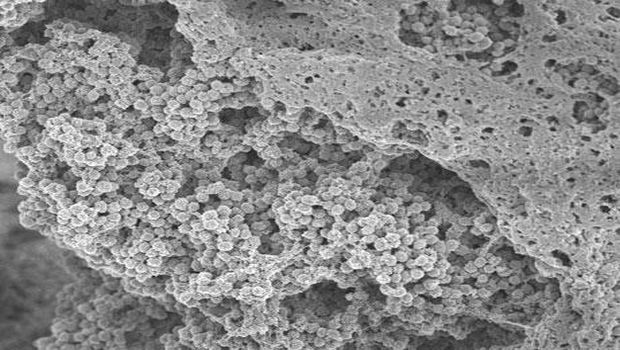New Technique Could Prevent Dangerous Biofilms on Catheters
Biofilms frequently coat the surfaces of catheters, and of various medical implants and prostheses, where they can cause life-threatening infections. New research at the Sahlgrenska Academy show that coating implants with a certain "activator" can prevent Staphylococcus aureus, the leading cause of hospital-acquired infections, from forming biofilms.


This image shows Staphylococcus aureus bacteria forming biofilm. Courtesy of University of Gothenburg
Biofilms frequently coat the surfaces of catheters, and of various medical implants and prostheses, where they can cause life-threatening infections. New research at the Sahlgrenska Academy show that coating implants with a certain "activator" can prevent Staphylococcus aureus, the leading cause of hospital-acquired infections, from forming biofilms.
Biofilms are mats of bacteria similar to the plaque that grows on teeth. Biofilms frequently coat the surfaces of catheters, and of various medical implants and prostheses, where they can threaten lives or lead to failure of the implants.
Antibiotics are impotent against biofilms. Now Gothenburg researchers Jakub Kwiecinski, Tao Jin and collaborators show that coating implants with "tissue plasminogen activator" can prevent Staphylococcus aureus, the leading cause of hospital-acquired infections, from forming biofilms.
A growing biofilm requires anchoring, and in earlier research, this team, led by Jin, an associate professor of rheumatology and inflammation research, the University of Gothenburg in Gothenburg, Sweden, had discovered that S. aureus hijacks the human clotting system to create a scaffold of micro-clots to support the growing biofilm.
"We hypothesized that if we forced the human body to start dissolving those clots, we could prevent the biofilm from developing," says Kwiecinski, a post-doctoral researcher in Jin's laboratory.
To encouraging the clot-busting, the investigators coated the surfaces with tissue plasminogen activator (tPA), which activates the clot-dissolving protein, plasminogen.
"This deprives S. aureus of a scaffold for biofilm formation and prevents infection," says Kwiecinski. After performing the research under laboratory conditions, they confirmed that it works by coating catheters that they then implanted into laboratory mice.
A key to the team's success was their decision to look beyond the bacteria, the stopping place for most previous research, to the human body's involvement in the infections, said Kwiecinski. The clot-busting, he said, could be applied to biofilms of pathogens other than S. aureus.
Biofilm-related infections afflict around 1.7 million in the US alone, killing nearly 100,000 annually, according to the Centers for Disease Control and Prevention (CDC). "With increasing numbers of prosthetic devices used in modern medicine, this number is only going to increase," says Kwiecinski. Thus, the research could lead to a major reduction in hospital-acquired disease and death.
Source: University of Gothenburg
Uncovering a Hidden Risk: Alcohol Use Disorder Significantly Increases C difficile Infection Rates
April 10th 2025A groundbreaking study reveals a strong connection between alcohol use disorder and increased risk for Clostridioides difficile infection, challenging traditional assumptions and calling for enhanced infection prevention protocols.